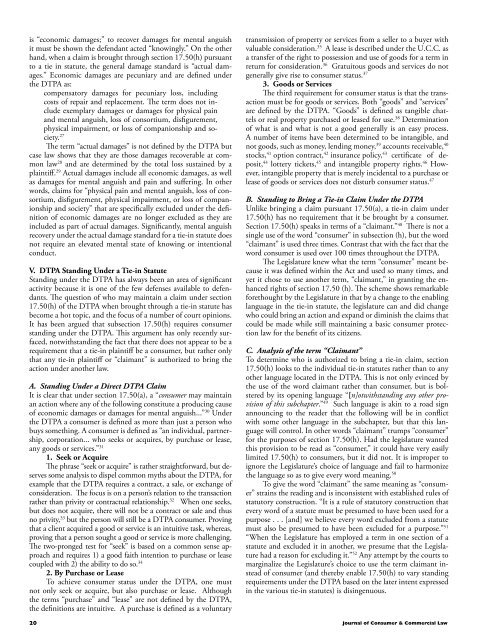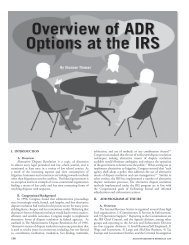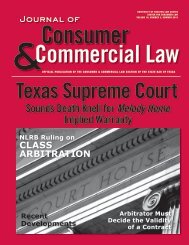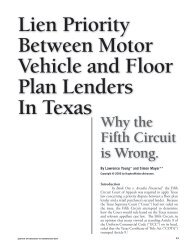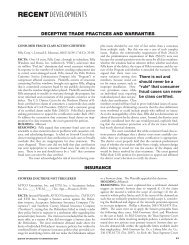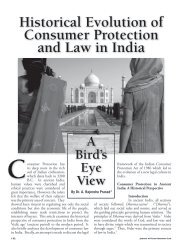Teaching Consumer Credit Law in an Evolving Australian Economy
Teaching Consumer Credit Law in an Evolving Australian Economy
Teaching Consumer Credit Law in an Evolving Australian Economy
Create successful ePaper yourself
Turn your PDF publications into a flip-book with our unique Google optimized e-Paper software.
is “economic damages;” to recover damages for mental <strong>an</strong>guish<br />
it must be shown the defend<strong>an</strong>t acted “know<strong>in</strong>gly.” On the other<br />
h<strong>an</strong>d, when a claim is brought through section 17.50(h) pursu<strong>an</strong>t<br />
to a tie <strong>in</strong> statute, the general damage st<strong>an</strong>dard is “actual damages.”<br />
Economic damages are pecuniary <strong>an</strong>d are def<strong>in</strong>ed under<br />
the DTPA as:<br />
compensatory damages for pecuniary loss, <strong>in</strong>clud<strong>in</strong>g<br />
costs of repair <strong>an</strong>d replacement. The term does not <strong>in</strong>clude<br />
exemplary damages or damages for physical pa<strong>in</strong><br />
<strong>an</strong>d mental <strong>an</strong>guish, loss of consortium, disfigurement,<br />
physical impairment, or loss of comp<strong>an</strong>ionship <strong>an</strong>d society.<br />
27<br />
The term “actual damages” is not def<strong>in</strong>ed by the DTPA but<br />
case law shows that they are those damages recoverable at common<br />
law 28 <strong>an</strong>d are determ<strong>in</strong>ed by the total loss susta<strong>in</strong>ed by a<br />
pla<strong>in</strong>tiff. 29 Actual damages <strong>in</strong>clude all economic damages, as well<br />
as damages for mental <strong>an</strong>guish <strong>an</strong>d pa<strong>in</strong> <strong>an</strong>d suffer<strong>in</strong>g. In other<br />
words, claims for “physical pa<strong>in</strong> <strong>an</strong>d mental <strong>an</strong>guish, loss of consortium,<br />
disfigurement, physical impairment, or loss of comp<strong>an</strong>ionship<br />
<strong>an</strong>d society” that are specifically excluded under the def<strong>in</strong>ition<br />
of economic damages are no longer excluded as they are<br />
<strong>in</strong>cluded as part of actual damages. Signific<strong>an</strong>tly, mental <strong>an</strong>guish<br />
recovery under the actual damage st<strong>an</strong>dard for a tie-<strong>in</strong> statute does<br />
not require <strong>an</strong> elevated mental state of know<strong>in</strong>g or <strong>in</strong>tentional<br />
conduct.<br />
V. DTPA St<strong>an</strong>d<strong>in</strong>g Under a Tie-<strong>in</strong> Statute<br />
St<strong>an</strong>d<strong>in</strong>g under the DTPA has always been <strong>an</strong> area of signific<strong>an</strong>t<br />
activity because it is one of the few defenses available to defend<strong>an</strong>ts.<br />
The question of who may ma<strong>in</strong>ta<strong>in</strong> a claim under section<br />
17.50(h) of the DTPA when brought through a tie-<strong>in</strong> statute has<br />
become a hot topic, <strong>an</strong>d the focus of a number of court op<strong>in</strong>ions.<br />
It has been argued that subsection 17.50(h) requires consumer<br />
st<strong>an</strong>d<strong>in</strong>g under the DTPA. This argument has only recently surfaced,<br />
notwithst<strong>an</strong>d<strong>in</strong>g the fact that there does not appear to be a<br />
requirement that a tie-<strong>in</strong> pla<strong>in</strong>tiff be a consumer, but rather only<br />
that <strong>an</strong>y tie-<strong>in</strong> pla<strong>in</strong>tiff or “claim<strong>an</strong>t” is authorized to br<strong>in</strong>g the<br />
action under <strong>an</strong>other law.<br />
A. St<strong>an</strong>d<strong>in</strong>g Under a Direct DTPA Claim<br />
It is clear that under section 17.50(a), a “consumer may ma<strong>in</strong>ta<strong>in</strong><br />
<strong>an</strong> action where <strong>an</strong>y of the follow<strong>in</strong>g constitute a produc<strong>in</strong>g cause<br />
of economic damages or damages for mental <strong>an</strong>guish...” 30 Under<br />
the DTPA a consumer is def<strong>in</strong>ed as more th<strong>an</strong> just a person who<br />
buys someth<strong>in</strong>g. A consumer is def<strong>in</strong>ed as “<strong>an</strong> <strong>in</strong>dividual, partnership,<br />
corporation... who seeks or acquires, by purchase or lease,<br />
<strong>an</strong>y goods or services.” 31<br />
1. Seek or Acquire<br />
The phrase “seek or acquire” is rather straightforward, but deserves<br />
some <strong>an</strong>alysis to dispel common myths about the DTPA, for<br />
example that the DTPA requires a contract, a sale, or exch<strong>an</strong>ge of<br />
consideration. The focus is on a person’s relation to the tr<strong>an</strong>saction<br />
rather th<strong>an</strong> privity or contractual relationship. 32 When one seeks,<br />
but does not acquire, there will not be a contract or sale <strong>an</strong>d thus<br />
no privity, 33 but the person will still be a DTPA consumer. Prov<strong>in</strong>g<br />
that a client acquired a good or service is <strong>an</strong> <strong>in</strong>tuitive task, whereas,<br />
prov<strong>in</strong>g that a person sought a good or service is more challeng<strong>in</strong>g.<br />
The two-pronged test for “seek” is based on a common sense approach<br />
<strong>an</strong>d requires 1) a good faith <strong>in</strong>tention to purchase or lease<br />
coupled with 2) the ability to do so. 34<br />
2. By Purchase or Lease<br />
To achieve consumer status under the DTPA, one must<br />
not only seek or acquire, but also purchase or lease. Although<br />
the terms “purchase” <strong>an</strong>d “lease” are not def<strong>in</strong>ed by the DTPA,<br />
the def<strong>in</strong>itions are <strong>in</strong>tuitive. A purchase is def<strong>in</strong>ed as a voluntary<br />
tr<strong>an</strong>smission of property or services from a seller to a buyer with<br />
valuable consideration. 35 A lease is described under the U.C.C. as<br />
a tr<strong>an</strong>sfer of the right to possession <strong>an</strong>d use of goods for a term <strong>in</strong><br />
return for consideration. 36 Gratuitous goods <strong>an</strong>d services do not<br />
generally give rise to consumer status. 37<br />
3. Goods or Services<br />
The third requirement for consumer status is that the tr<strong>an</strong>saction<br />
must be for goods or services. Both “goods” <strong>an</strong>d “services”<br />
are def<strong>in</strong>ed by the DTPA. “Goods” is def<strong>in</strong>ed as t<strong>an</strong>gible chattels<br />
or real property purchased or leased for use. 38 Determ<strong>in</strong>ation<br />
of what is <strong>an</strong>d what is not a good generally is <strong>an</strong> easy process.<br />
A number of items have been determ<strong>in</strong>ed to be <strong>in</strong>t<strong>an</strong>gible, <strong>an</strong>d<br />
not goods, such as money, lend<strong>in</strong>g money, 39 accounts receivable, 40<br />
stocks, 41 option contract, 42 <strong>in</strong>sur<strong>an</strong>ce policy, 43 certificate of deposit,<br />
44 lottery tickets, 45 <strong>an</strong>d <strong>in</strong>t<strong>an</strong>gible property rights. 46 However,<br />
<strong>in</strong>t<strong>an</strong>gible property that is merely <strong>in</strong>cidental to a purchase or<br />
lease of goods or services does not disturb consumer status. 47<br />
B. St<strong>an</strong>d<strong>in</strong>g to Br<strong>in</strong>g a Tie-<strong>in</strong> Claim Under the DTPA<br />
Unlike br<strong>in</strong>g<strong>in</strong>g a claim pursu<strong>an</strong>t 17.50(a), a tie-<strong>in</strong> claim under<br />
17.50(h) has no requirement that it be brought by a consumer.<br />
Section 17.50(h) speaks <strong>in</strong> terms of a “claim<strong>an</strong>t.” 48 There is not a<br />
s<strong>in</strong>gle use of the word “consumer” <strong>in</strong> subsection (h), but the word<br />
“claim<strong>an</strong>t” is used three times. Contrast that with the fact that the<br />
word consumer is used over 100 times throughout the DTPA.<br />
The Legislature knew what the term “consumer” me<strong>an</strong>t because<br />
it was def<strong>in</strong>ed with<strong>in</strong> the Act <strong>an</strong>d used so m<strong>an</strong>y times, <strong>an</strong>d<br />
yet it chose to use <strong>an</strong>other term, “claim<strong>an</strong>t,” <strong>in</strong> gr<strong>an</strong>t<strong>in</strong>g the enh<strong>an</strong>ced<br />
rights of section 17.50 (h). The scheme shows remarkable<br />
forethought by the Legislature <strong>in</strong> that by a ch<strong>an</strong>ge to the enabl<strong>in</strong>g<br />
l<strong>an</strong>guage <strong>in</strong> the tie-<strong>in</strong> statute, the legislature c<strong>an</strong> <strong>an</strong>d did ch<strong>an</strong>ge<br />
who could br<strong>in</strong>g <strong>an</strong> action <strong>an</strong>d exp<strong>an</strong>d or dim<strong>in</strong>ish the claims that<br />
could be made while still ma<strong>in</strong>ta<strong>in</strong><strong>in</strong>g a basic consumer protection<br />
law for the benefit of its citizens.<br />
C. Analysis of the term “Claim<strong>an</strong>t”<br />
To determ<strong>in</strong>e who is authorized to br<strong>in</strong>g a tie-<strong>in</strong> claim, section<br />
17.50(h) looks to the <strong>in</strong>dividual tie-<strong>in</strong> statutes rather th<strong>an</strong> to <strong>an</strong>y<br />
other l<strong>an</strong>guage located <strong>in</strong> the DTPA. This is not only ev<strong>in</strong>ced by<br />
the use of the word claim<strong>an</strong>t rather th<strong>an</strong> consumer, but is bolstered<br />
by its open<strong>in</strong>g l<strong>an</strong>guage “[n]otwithst<strong>an</strong>d<strong>in</strong>g <strong>an</strong>y other provision<br />
of this subchapter.” 49 Such l<strong>an</strong>guage is ak<strong>in</strong> to a road sign<br />
<strong>an</strong>nounc<strong>in</strong>g to the reader that the follow<strong>in</strong>g will be <strong>in</strong> conflict<br />
with some other l<strong>an</strong>guage <strong>in</strong> the subchapter, but that this l<strong>an</strong>guage<br />
will control. In other words “claim<strong>an</strong>t” trumps “consumer”<br />
for the purposes of section 17.50(h). Had the legislature w<strong>an</strong>ted<br />
this provision to be read as “consumer,” it could have very easily<br />
limited 17.50(h) to consumers, but it did not. It is improper to<br />
ignore the Legislature’s choice of l<strong>an</strong>guage <strong>an</strong>d fail to harmonize<br />
the l<strong>an</strong>guage so as to give every word me<strong>an</strong><strong>in</strong>g. 50<br />
To give the word “claim<strong>an</strong>t” the same me<strong>an</strong><strong>in</strong>g as “consumer”<br />
stra<strong>in</strong>s the read<strong>in</strong>g <strong>an</strong>d is <strong>in</strong>consistent with established rules of<br />
statutory construction. “It is a rule of statutory construction that<br />
every word of a statute must be presumed to have been used for a<br />
purpose . . . [<strong>an</strong>d] we believe every word excluded from a statute<br />
must also be presumed to have been excluded for a purpose.” 51<br />
“When the Legislature has employed a term <strong>in</strong> one section of a<br />
statute <strong>an</strong>d excluded it <strong>in</strong> <strong>an</strong>other, we presume that the Legislature<br />
had a reason for exclud<strong>in</strong>g it.” 52 Any attempt by the courts to<br />
marg<strong>in</strong>alize the Legislature’s choice to use the term claim<strong>an</strong>t <strong>in</strong>stead<br />
of consumer (<strong>an</strong>d thereby enable 17.50(h) to vary st<strong>an</strong>d<strong>in</strong>g<br />
requirements under the DTPA based on the later <strong>in</strong>tent expressed<br />
<strong>in</strong> the various tie-<strong>in</strong> statutes) is dis<strong>in</strong>genuous.<br />
20 Journal of <strong>Consumer</strong> & Commercial <strong>Law</strong>


